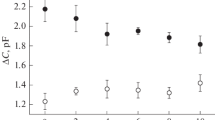Summary
Vesicles with proton translocating activity were reconstituted with bacterial rhodopsin lipoprotein and synthetic phospholipids. Reconstitution with dimyristoyl phosphatidylcholine yielded vesicles which catalyzed light-driven proton uptake which was sensitive to nigericin, gramicidin or an uncoupler when tested at temperatures above 20°C. At temperatures below 5°C, the extent of proton uptake was actually greater than at 20°C, but there was little effect of either nigericin or uncouplers even when these compounds had been added at 20°C. Gramicidin inhibited at all assay temperatures provided it was added at 20°C. With dipalmitoyl phosphatidylcholine similar results were obtained except that nigericin lost its effectiveness at higher temperatures. On illumination tetraphenylboron was taken up by the reconstituted vesicles. We propose that an electrogenic proton translocation takes place by a channel mechanism.
Similar content being viewed by others
References
Grinius, L. L., Jasaitis, A. A., Kadziauskas, J. P., Liberman, E. A., Skulachev, V. P., Topali, V. P., Tsofina, L. M., Vladimirova, M. A. 1970. Conversion of biomembrane produced energy into electric form.Biochim. Biophys. Acta 216:1
Hinz, H. J., Sturtevant, J. M. 1972. Calorimetric investigation of the influence of cholesterol on the transition properties of bilayers formed from syntheticL-lecithins in aqueous suspension.J. Biol. Chem. 247:3697
Krasne, S., Eisenman, H., Szabo, G. 1971. Freezing and melting of lipid bilayers and the mode of action of nonactin, valinomycin and gramicidin.Science 174:412
Mueller, P., Rudin, D. O. 1969. Translocators in bimolecular lipid membranes: Their role in dissipative and conservative bioenergy transductions.In: Current Topics in Bioenergetics. D. R. Sanadi, editor. Vol. 3, p. 157. Academic Press Inc., N.Y.
Oesterhelt, D., Stoeckenius, W. 1971. Rhodopsin-like protein from the purple membrane ofHalobacterium halobium.Nature, New Biol. 233:149
Oesterhelt, D., Stoeckenius, W. 1973. Functions of a new photoreceptor membrane.Proc. Nat. Acad. Sci. 70:2853
Papahadjopoulos, D., Jacobson, K., Nir, S., Isac, T. 1973. Phase transitions in phospholipid vesicles. Fluorescence polarization and permeability measurements concerning the effect of temperature and cholesterol.Biochim. Biophys. Acta 311:330
Racker, E. 1973. A new procedure for the reconstitution of biologically active phospholipid vesicles.Biochem. Biophys. Res. Commun. 55:244
Racker, E., Stoeckenius, W. 1974. Reconstitution of purple membrane vesicles catalyzing light-driven proton uptake and ATP formation.J. Biol. Chem. 249:662
Author information
Authors and Affiliations
Rights and permissions
About this article
Cite this article
Racker, E., Hinkle, P.C. Effect of temperature on the function of a proton pump. J. Membrain Biol. 17, 181–188 (1974). https://doi.org/10.1007/BF01870178
Received:
Issue Date:
DOI: https://doi.org/10.1007/BF01870178




